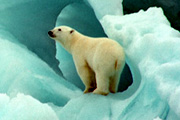Statics and Facts
Statics
- Weight: 352-680 kg (780 - 1,500 lb)
- Length: 2 - 3 m (6.5 - 9.8 ft)
*Females are usually half the size of males, unless pregnant
- Largest Polar Bear recorded: 1,002 kg (2,210 lb)
- Largest Kodiak bear recorded: 1,134 kg (2,500 lb)
- Average swimming speed: 9.7 kph (6 mph)
- Average walking speed: 5.5 kph (3.5 mph)
- Maximum running speed: 40 kph (25 mph)
- Teeth: 42
- Paw size: up to 30 cm across (12 in)
- Tongue: dark blue/black
- Skin: black
- Claws: curved, non-retractable
- Eyes: dark brown
- Tail: 7 - 12 cm (2.8 - 4.7 in)
- Hair: 2.5 - 5 cm (1 -2 in) with a second insulating underlayer (called the guard layer)
Facts
- Polar bears are the top predator in the arctic marine ecosystem
- They evolved from brown bears during the Pleistocene, the time period that spanned from 1.8 million to 11,000 years ago.
- Polar bears have adapted to life in the north where temperatures do not exceed 10¡ãC (50¡ãF) in summer and typically fall to -30¡ãC (-22¡ãF) during winter.
- A layer of fat up to 11 cm (4.3 in) thick keeps the bears warm, especially while swimming.
- Polar bears are so well insulated that they have to move slowly to avoid overheating.
- Their thick coat is made up of a double layer of water repellent hairs that conserve heat.
- Under their dense fur is black skin, good for absorbing the rays of the arctic sun.
- Polar bears have enormous paws that function like snowshoes, distributing their weight to keep them from breaking through ice and snow.
- The pads of their feet are covered with soft, tiny growths called papillae, which increase friction between paw and ice and reduce the chance of slipping.
- Polar bear claws are shorter, and more solid than their grizzly bear cousins, better suited for walking on ice or climbing steep banks.
- They have sharp, jagged back teeth, and canines that are larger and sharper than grizzly teeth.
- However they swallow their food in large chunks rather than chewing
POLAR BEAR

